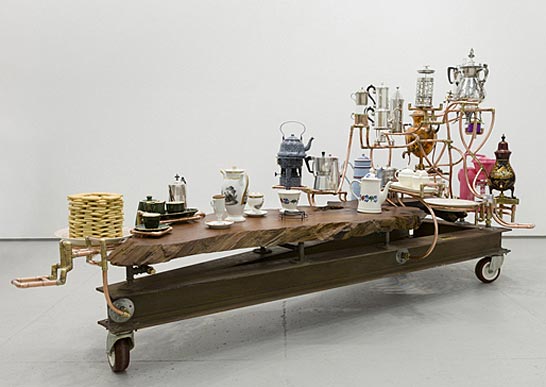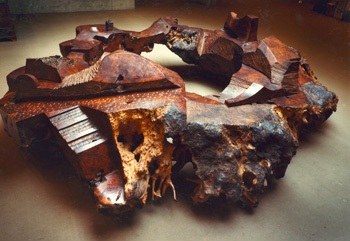I had not seen Joel Otterson’s work or heard of him for nearly 20 years but wondered what happened to him. Was he one of the many casualties of the art world? Was he laying low through choice? Had he stopped making art to move onto something else more enjoyable and profitable? I had always been drawn to his frank combination of kitsch kitchenware and high art tinkering, between excessive baroque expression and useful objects. So, like many others, I am pleased with the acclaim he is receiving from his participation in this year’s Whitney Biennial (2014).
Not long after seeing his sculptures in the Biennial I went to the Elizabeth Dee Gallery and saw a selection of Otterson’s work from the 1980s. I had an odd experience of remembering long-forgotten connections to his work, especially when looking at Coffee Table Museum from 1989. I had forgotten that I wrote a review about Otterson in the May, 1990 issue of Flash Art. I also realized how my knowledge of his work helped me map out the direction of my own sculpture at that time. It was not influence, per se, but the example of his work allowed me to say “yes” to suppressed aspects of my background.
As an adolescent I was fascinated by the wood burl tables being sold by the side of the road, north of San Francisco. And because I went to a summer camp with the son of J.B. Blunk, I was introduced, at around the same age, to Blunk’s functional sculpture carved from the great redwoods of California. I loved his work. Blunk was also one of the few working artists in my life who existed outside of a book or a museum. After studying art and moving to New York, I suppressed the resonance of Blunk’s approach as too hippy, too touchy-feely, too generous, too far outside the austere artistic canon, too Californian. As I worked to find my own path as an artist, these rejected California precedents kept coming to mind with an insistence that I could not ignore. Seeing Otterson’s work was one step in acknowledging the entirety of my artistic heritage, including sculptural practices overlooked by the high art mainstream. And now many years later, the results of my encounter with Otterson are fairly apparent in pieces like Flare and Falter.
I have become increasingly fascinated by the many positive ways artists “use” other artists. Establishing an artistic practice is aided and abetted by others. My exposure to Otterman and Blunk was important in my progression, yet such connections could easily go undetected when looking at my work today. However subtly, their art remains deeply embedded in my thinking and making.
The following review was first published by Flash Art in May/June 1990. See the most recent issue here.
Joel Otterson
Jay Gorney
Flash Art, 1990
A bed, a table, chairs, and a painting are all objects that are found in almost every home. They are also found in Joel Otterson’s recent show at Jay Gorney, but enlarged and elaborated to such an extent they become little worlds into themselves. Otterson’s objects look like they come from a place where the party never ends and one never wakes up with a hangover. His Disco’s Bed/Rocking “Craftmatic” Disco, Canopy Bed dominates the first floor of the gallery, suggesting a bed from a disco fairytale fit for a queen. It’s constructed from sturdy copper tubing, sports a full stereo system, disco lights, mirror ball, silver studded comforter, and metallic lace curtains, and is mounted on rockers. In other words, it has everything necessary for rocking and rolling. One need never leave this self-sufficient unit. It is hard not to laugh at the tacky charm of the 70s from which the look of this piece derives, while also viewing it as an historical monument to the not-so-distant past, a contemporary version of equestrian statuary, appropriately changing the site of heroism from horse to bed.
Love seat/Cura Te Ipsum works in tandem with Disco Bed, not only sharing early 70s motifs but also as another tableau vivant of plentitude. The loveseat is flanked by two large baskets of fresh fruit referring to any number of painted cornucopia. While in Chardin’s still lifes, for instance, the perfectly ripe fruit exists in the magical present preserved by the meticulous craft of painting, in the age of the refigerator and Dean and Deluca, still lifes of Chardin’s kind are no longer necessary. Otterson need only visit the corner market to replenish his vision of the perfect enviornment for romance.
Downstairs a gigantic table made from red wool and myrtle wood burls inlayed with turquoise and glass becomes a literal moveable feast as it is equipped with bronze piano wheels. It looks like the product of a California craftsman gone wacko from too much speed. Even its excessiveness has become excessive.
If Scott Burton sought to reintroduce the functional into the uselessness of high art by transforming minimalism into furniture, Otterson does the opposite. By enhancing at least nominally useful objects he exaggerates their absurdity, thereby rendering them endearingly useless and creates in each a miniature paradise of consumption and consummation. It is an especially American paradise where the streets are not paved with gold but with Hershey Bars. (A tapestry of discarded containers, gallery announcements, and various wrappers grace the wall behind the large table.) Certainly, we’ve come to realize that paradise such as this is not only unworkable and unfulfilling, but even downright destructive. Despite this, Otterson seems to neither celebrate a bygone era nor point a didactic finger at our weaknesses, but to have submerged himself in the potent yet absurd wish for heaven and earth.
-Daniel Wiener

